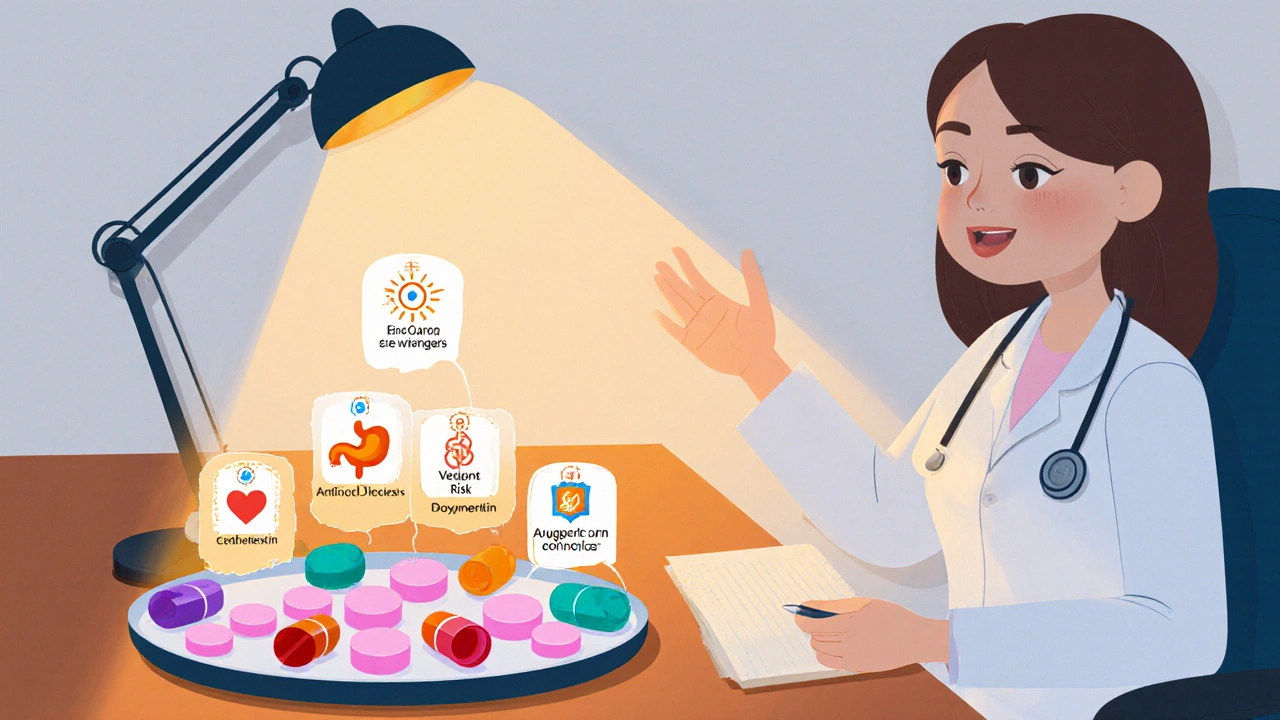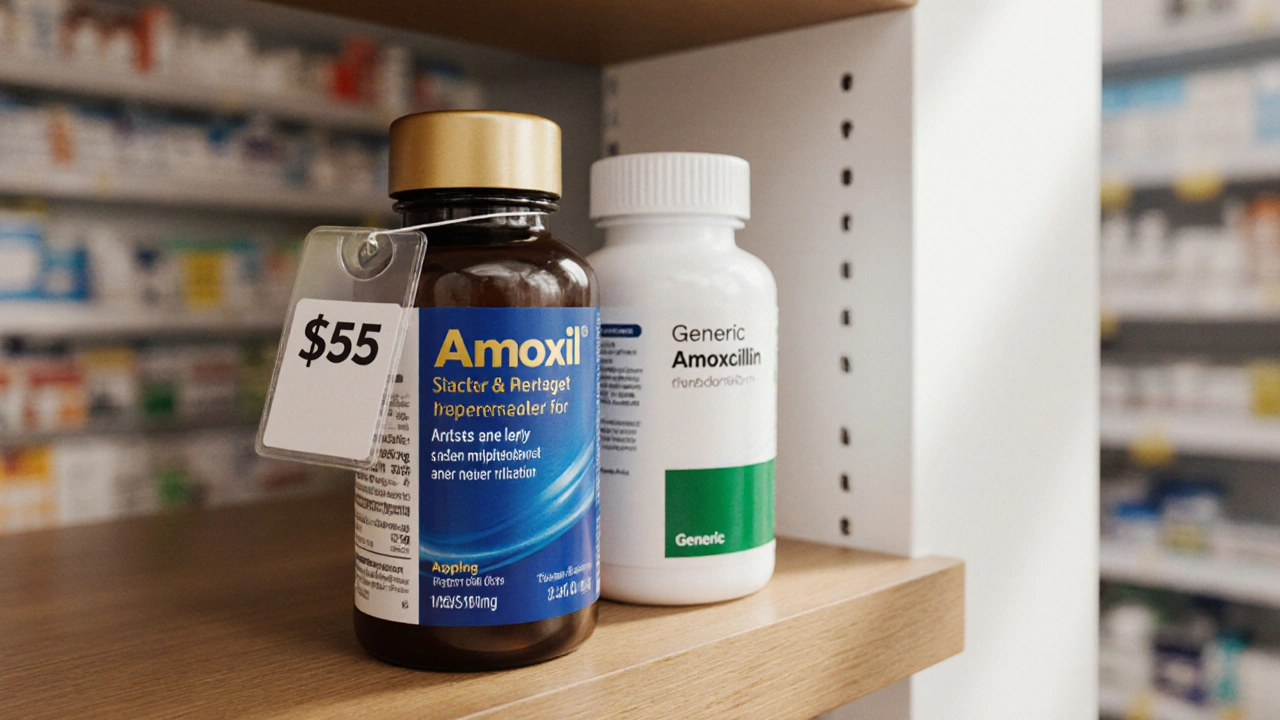Amoxil vs Alternatives: Antibiotic Comparison Tool
Use this tool to compare Amoxil and its alternatives based on key factors:
Chemically identical but Amoxil is more expensive due to branding. Generic versions are preferred for cost-conscious patients.
| Antibiotic | Cost (14-day supply) |
|---|---|
| Amoxil | $45-$60 |
| Generic Amoxicillin | $10-$20 |
| Cephalexin | $12-$25 |
| Azithromycin | $30-$45 |
When your doctor prescribes a course of antibiotics, you often see brand names you don’t recognize. Amoxil is one of those names - it’s the branded version of the widely used penicillin‑type antibiotic amoxicillin. Understanding what makes Amoxil different from generic amoxicillin and from other common antibiotics can save you money, reduce side‑effects, and help you finish treatment successfully.
What Is Amoxil and When Is It Used?
Amoxil contains 500mg or 875mg of amoxicillin per tablet, formulated by GlaxoSmithKline. It belongs to the β‑lactam class and works by interfering with the bacterial cell wall synthesis, causing the bacteria to burst. Doctors prescribe it for a range of infections such as:
- Acute otitis media (middle‑ear infection)
- Strep throat
- Sinusitis
- Urinary tract infections caused by susceptible strains
- Dental abscesses
The drug is taken orally, usually twice a day, and a typical adult course lasts 7‑10days.
Key Alternatives to Amoxil
When an allergy, resistance, or cost issue arises, doctors may switch to one of several alternatives. Below are the most common options, each with its own strengths and drawbacks.
- Generic amoxicillin - chemically identical to Amoxil but sold by many manufacturers at a lower price.
- Cephalexin - a first‑generation cephalosporin that works on many of the same bacteria but is a good choice for patients with mild penicillin allergies.
- Azithromycin - a macrolide with a longer half‑life, allowing once‑daily dosing, often used for respiratory infections.
- Doxycycline - a tetracycline derivative useful for atypical bacteria and certain tick‑borne illnesses.
- Amoxicillin‑clavulanic acid (often sold as Augmentin) - combines amoxicillin with a β‑lactamase inhibitor to tackle resistant strains.
Side‑Effect Profile: How Do They Compare?
All antibiotics can cause side effects, but the frequency and severity differ. Here’s a quick snapshot:
- Amoxil / generic amoxicillin: mild gastrointestinal upset (nausea, diarrhea) in up to 15% of users; rare rash.
- Cephalexin: similar GI profile, slightly higher risk of allergic skin reactions (around 5%).
- Azithromycin: can cause heart rhythm changes (QT prolongation) in patients with existing cardiac issues; also associated with abdominal pain.
- Doxycycline: photosensitivity, esophageal irritation, and rare liver enzyme elevations.
- Amoxicillin‑clavulanic acid: higher incidence of diarrhea (up to 25%) and occasional liver enzyme spikes.
When you have a history of allergies or a specific medical condition, these nuances become decisive.

Cost Considerations
Price can be a deal‑breaker, especially for those without insurance. Below is an average U.S. retail price (October 2025) for a 14‑day supply:
| Antibiotic | Typical Strength | Average Cost | Insurance Coverage |
|---|---|---|---|
| Amoxil (brand) | 500mg | $45‑$60 | Partial |
| Generic amoxicillin | 500mg | $10‑$20 | Full |
| Cephalexin | 500mg | $12‑$25 | Full |
| Azithromycin | 250mg | $30‑$45 | Partial |
| Doxycycline | 100mg | $15‑$30 | Full |
| Amoxicillin‑clavulanic acid | 875mg/125mg | $35‑$50 | Partial |
In most cases, the generic version of amoxicillin delivers the same therapeutic effect at a fraction of the cost, making it the first line for price‑sensitive patients.
Resistance and When to Choose an Alternative
Antibiotic resistance is a growing public‑health challenge. Amoxicillin works well against Streptococcus pneumoniae and Haemophilus influenzae, but resistance rates in certain regions exceed 30%. When labs report a resistant strain, doctors often turn to:
- Amoxicillin‑clavulanic acid - the clavulanic acid blocks β‑lactamase enzymes that many bacteria produce.
- Azithromycin - effective against atypical pathogens like Mycoplasma pneumoniae.
- Doxycycline - covers a broader spectrum, including some resistant Gram‑negative bugs.
Choosing the right drug therefore hinges on local resistance patterns and test results.
How to Talk to Your Doctor About Switching
If you’re worried about cost, side effects, or a potential allergy, bring these points to the appointment:
- Ask if a generic amoxicillin prescription is appropriate for your infection.
- Explain any previous reactions to penicillins or cephalosporins.
- Inquire about the likelihood of resistance based on recent cultures.
- Request a price comparison if you’re paying out‑of‑pocket.
Most clinicians appreciate an informed patient and will gladly discuss alternatives like cephalexin or azithromycin when medically justified.
Bottom Line: Picking the Right Antibiotic
Here’s a quick decision guide:
- First choice for typical ear, throat, or sinus infections: Amoxil or generic amoxicillin - cheap, well‑studied, and effective.
- Penicillin allergy (mild): Cephalexin - similar coverage with lower cross‑reactivity.
- Known β‑lactamase‑producing bacteria: Amoxicillin‑clavulanic acid - added inhibitor restores activity.
- Need for once‑daily dosing or treat atypical pneumonia: Azithromycin - convenient but watch for heart‑risk warnings.
- Skin infections, tick‑borne disease, or when a broad spectrum is needed: Doxycycline - handles a different set of bugs.
Always complete the full course, even if you feel better before it’s over. Stopping early fuels resistance and invites relapse.

Frequently Asked Questions
Is Amoxil the same as generic amoxicillin?
Yes. Chemically they are identical. Amoxil is just a branded name, which usually carries a higher price tag due to brand‑marketing costs.
Can I use amoxicillin if I’m allergic to penicillin?
Mild penicillin sensitivities sometimes tolerate amoxicillin, but a true IgE‑mediated allergy can cause serious reactions. In that case, doctors often choose a cephalosporin like cephalexin (if the allergy isn’t severe) or a completely different class such as azithromycin.
Why does my pharmacy charge more for Amoxil than for generic amoxicillin?
Brand drugs carry the manufacturer's name and often include extra packaging or marketing fees. Generic manufacturers can sell the same active ingredient at lower cost because they don’t pay for brand promotion.
When should I consider switching to azithromycin?
If you have a known macrolide‑sensitive infection, like atypical pneumonia or certain sexually transmitted infections, or if you cannot tolerate beta‑lactams, azithromycin’s once‑daily dosing makes it a convenient alternative.
Does taking amoxicillin‑clavulanic acid increase the risk of side effects?
Yes, the addition of clavulanic acid raises the likelihood of diarrhea and can affect liver enzymes. Your doctor will weigh this against the need to overcome beta‑lactamase‑producing bacteria.






11 Comments
Murhari Patil
October 4, 2025 AT 17:00 PMThey hide the truth behind bright pills, the pharma giants conspire to keep Amoxil pricey while the cheap generic is shoved aside.
kevin joyce
October 4, 2025 AT 19:46 PMWhen we deconstruct the epistemic framework of antibiotic selection, we encounter a multilayered confluence of pharmacodynamics, health economics, and sociocultural narratives. The ontological substrate of Amoxil versus generic amoxicillin is not merely a biochemical equivalence but a signifier within the capitalist pharmacopeia. Its elevated cost functions as a hegemonic instrument, reinforcing the stratification of access to care. Moreover, the inclusion of the brand name in prescriptive discourse perpetuates a semiotic hierarchy that privileges the proprietary over the public good. From a systems theory perspective, this dynamic engenders feedback loops that amplify demand for high-margin pharmaceuticals while marginalizing low-cost generics. The resulting entropy within the healthcare market manifests as increased out-of-pocket expenditures for patients, a phenomenon corroborated by longitudinal cost-utility analyses. In the realm of microbial ecology, the indiscriminate deployment of broad-spectrum agents such as azithromycin and doxycycline can precipitate dysbiosis, whereas the narrow-spectrum amoxicillin, when judiciously applied, mitigates collateral damage. Clinical guidelines therefore advocate for antimicrobial stewardship protocols that prioritize narrow-spectrum agents as first-line therapy. Yet, the inertia of entrenched prescribing habits and the influence of pharmaceutical lobbying often subvert evidence-based practice. It is incumbent upon clinicians to engage in epistemic humility, interrogating the narratives that undergird therapeutic choices. In doing so, one can reconcile the dialectic between efficacy, safety, and cost-effectiveness. The health economics literature underscores that generic substitution yields substantial savings without compromising therapeutic outcomes, a principle validated by meta-analytic comparisons of clinical endpoints. Consequently, a patient-centric approach necessitates transparency regarding drug pricing and the availability of generics. Ultimately, the decision matrix should integrate microbial susceptibility profiles, patient comorbidities, and fiscal considerations to optimize both individual and public health outcomes.
michael henrique
October 4, 2025 AT 23:06 PMStop lining up for overpriced brand meds; it’s a betrayal of real American values.
Jamie Balish
October 5, 2025 AT 02:43 AMHey, I get where you’re coming from, but let’s keep the conversation constructive. The core of the issue is that many people don’t realize there’s a cheaper, equally effective alternative. By choosing generic amoxicillin, you’re not only saving money but also supporting a more sustainable healthcare system. It’s a win‑win situation: patients get the treatment they need without breaking the bank, and insurers can lower overall costs. If you’ve ever felt pressured by a pharmacist to pick the brand name, you’re not alone-this happens far more often than we admit. Think of it as a small act of resistance against the profit‑driven model that keeps drug prices inflated. Also, remember that the side‑effect profiles are essentially identical, so there’s no clinical compromise. In the bigger picture, widespread generic use can reduce the pressure on the market to perpetuate high prices. So next time you’re prescribed Amoxil, ask your doctor if the generic version is appropriate for your infection; most will say yes. Let’s empower each other with this knowledge and keep the dialogue open and supportive.
Jeff Bellingham
October 5, 2025 AT 06:20 AMThe article is thorough, yet it neglects to address the impact of regional resistance patterns on antibiotic selection.
Matthew Balbuena
October 5, 2025 AT 09:40 AMYo, not gonna lie – the brand name stuff feels like a cash grab, while the generic does the same job for a fraction. If you’re watching your wallet, just go generic. No need to overcomplicate things.
michael abrefa busia
October 5, 2025 AT 13:50 PMGreat rundown! 👍💊💰 Choosing the right antibiotic can save you money and keep the microbes in check. 😊
Bansari Patel
October 5, 2025 AT 18:00 PMFrom a holistic standpoint, the decision to pick a cheaper generic isn’t just fiscal-it’s also ethical. By reducing unnecessary spending, we alleviate pressure on the healthcare system, which benefits everyone, especially those without robust insurance coverage.
Rebecca Fuentes
October 5, 2025 AT 22:10 PMThis comparative tool elegantly balances clinical nuance with economic reality, providing readers a clear framework for making informed choices about antibiotic therapy.
Jacqueline D Greenberg
October 6, 2025 AT 02:20 AMSuper helpful! I always wondered why my doctor sometimes picks the brand. Now I know I can ask for the generic and save some bucks.
Jim MacMillan
October 6, 2025 AT 06:30 AMWhile the layperson’s guide is adequate, it fails to capture the nuanced pharmacokinetic distinctions that seasoned clinicians appreciate. Nonetheless, a decent primer for the masses.